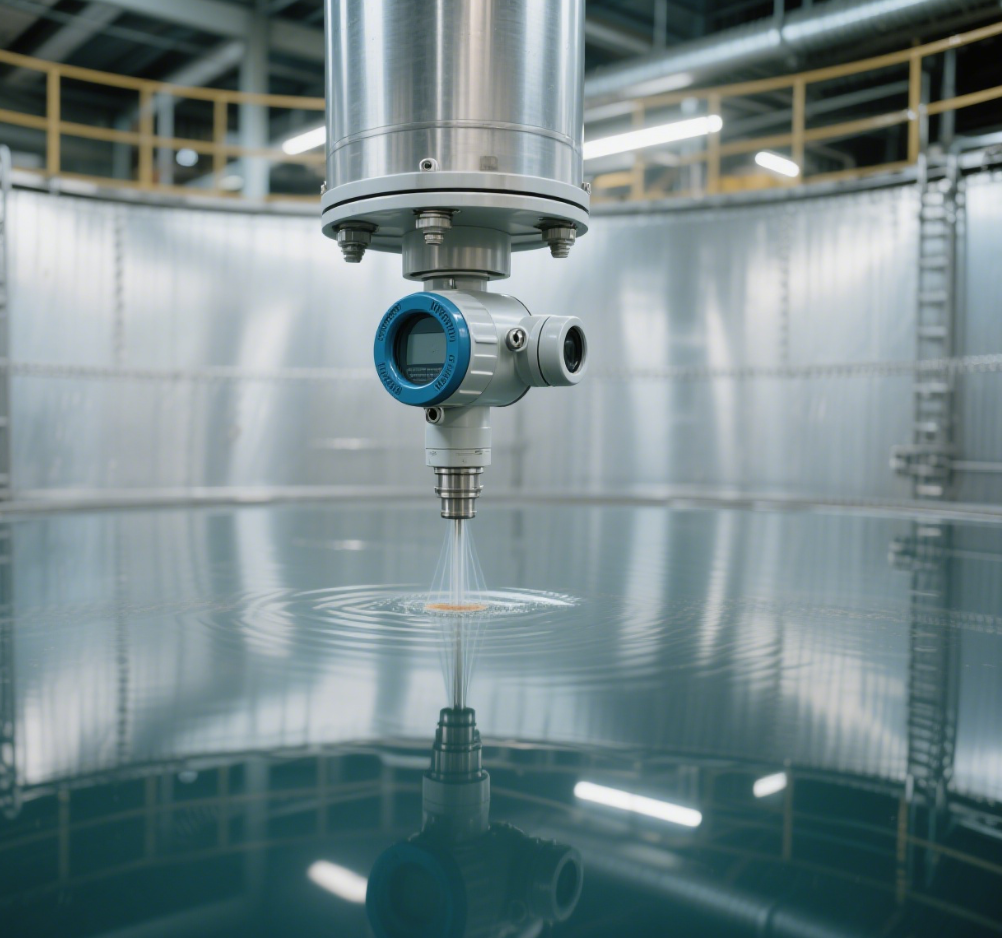Introduction
In industrial liquid measurement, ensuring accuracy is not only about choosing the right sensor but also about addressing the specific challenges of the environment. One of the most significant challenges for millimeter-wave (mmWave) radar level transmitters inside metal storage tanks is the so-called multipath effect. This phenomenon can lead to misleading readings if not properly managed. In this blog, we will dive into what multipath effects are, why they occur in metal tanks, and how advanced mmWave radar level transmitters are designed to overcome them.
What Is the Multipath Effect?
The multipath effect occurs when a radar signal, instead of traveling directly to the liquid surface and back, also reflects multiple times within the tank before returning to the radar antenna.
In metal tanks, the high reflectivity of the walls amplifies this issue. As a result, the radar receiver may receive several signals with different time delays, which can confuse the system and generate false echo peaks. This often manifests as:
-
Apparent “ghost levels” higher or lower than the real liquid surface
-
Fluctuating readings when the tank is partially filled
-
Reduced reliability in tall or narrow tanks
Why Metal Tanks Make It Worse
Unlike plastic or concrete tanks, which absorb some radar energy, metal walls act like mirrors. They trap and bounce signals repeatedly. The stronger the reflections, the more complex the radar’s echo pattern becomes.
For example:
-
In a 10-meter-tall cylindrical metal tank, a radar pulse may reflect off the liquid, bounce to the side wall, and return to the antenna with nearly the same delay as the true echo.
-
In conical-bottom tanks, echoes from angled surfaces can appear as strong as the true liquid surface signal.
Without smart processing, the radar cannot distinguish which echo is correct.
How Millimeter-Wave Radar Tackles Multipath
Modern mmWave radar transmitters integrate several design features and algorithms to mitigate multipath interference:
-
Narrow Beam Angle
High-frequency mmWave radars (77–81 GHz) can achieve beam angles as narrow as 3°–4°, minimizing the likelihood of hitting the tank wall and focusing more energy directly on the liquid surface. -
Advanced Echo Processing Algorithms
Signal processing software analyzes the strength, consistency, and timing of return signals. Algorithms filter out secondary reflections and lock onto the most probable true liquid surface. -
Dynamic False Echo Suppression
During initial setup, the radar can map out areas where false echoes are common (e.g., weld seams, ladders, or tank roofs). These zones are automatically suppressed in future measurements. -
High Dynamic Range (HDR) Detection
mmWave radars detect weak echoes even in the presence of strong multipath signals, improving measurement reliability in complex geometries.
Practical Example
Let’s consider a stainless steel ethanol storage tank:
-
Tank size: 12 meters tall, 4 meters in diameter
-
Challenge: Traditional 24 GHz radar level sensors reported unstable readings when the tank was between 50%–70% full due to multipath echoes.
-
Solution: Switching to a 77 GHz mmWave radar with a narrow beam angle and multipath suppression algorithm resulted in stable readings within ±2 mm accuracy.
This case demonstrates how multipath suppression is not just theoretical—it directly impacts operational efficiency and safety.
Integration with Industrial Applications
Millimeter-wave radar transmitters are now widely used in:
-
Chemical processing plants (where metallic vessels dominate)
-
Oil & gas storage (where tank safety demands accurate, continuous monitoring)
-
Pharmaceutical industries (where stainless steel tanks are mandatory)
For industries relying on metal tanks, understanding multipath effects and choosing the right radar sensor is critical for process reliability.
👉 For further details on radar technology, visit Linpowave’s official site.
👉 For background on radar principles, see Wikipedia: Radar Principles.
FAQ
Q1: Will multipath effects completely prevent accurate measurements?
No. While they complicate readings, modern mmWave radars with smart algorithms are designed to distinguish between true and false echoes, ensuring reliable performance.
Q2: Can multipath be avoided by installation alone?
Proper installation (e.g., positioning away from nozzles or weld seams) helps, but in metal tanks, algorithm-based suppression is essential.
Q3: Are 24 GHz radars equally capable?
Not usually. Their wider beam angle increases the risk of multipath, making them less effective in reflective metal tanks compared to 77 GHz radars.
Q4: How does multipath suppression improve safety?
By ensuring stable liquid measurements, it reduces risks of overfilling, leaks, and costly downtime.
Conclusion
Multipath effects inside metal tanks represent a critical challenge in liquid level measurement. However, with the advent of high-frequency mmWave radar sensors, combined with advanced signal processing, industries can now achieve stable, long-term measurements even in the most reflective environments.
When selecting a radar level transmitter for metal tanks, consider not just the frequency, but also the vendor’s expertise in multipath suppression algorithms. This is the difference between unstable measurements and reliable, continuous process control.



